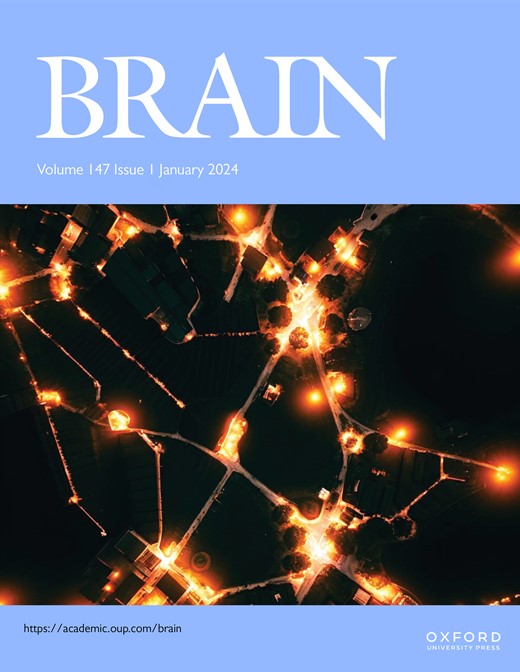异常纹状体放电介导帕金森病小鼠模型中的冲动决策。
IF 11.7
1区 医学
Q1 CLINICAL NEUROLOGY
引用次数: 0
摘要
帕金森病(PD)以进行性神经变性为特征,伴有运动和非运动症状。多巴胺替代疗法可以纠正运动症状,但也可能导致冲动控制障碍(ICD),其特征是病理性赌博、性欲亢进和/或强迫性购物。大约14-40%的PD患者患有ICD。尽管ICD在PD患者中的发病率很高,但我们对其机制知之甚少,主要的治疗策略是减少或消除多巴胺激动剂的使用。人体影像学研究表明基底神经节的输入核纹状体可能是ICD中电路功能障碍的关键部位。为了探索ICD的细胞和电路机制,我们建立了一个小鼠模型,在该模型中,我们给帕金森和健康对照小鼠注射多巴胺D2/3激动剂普拉克索。使用延迟贴现任务评估类似icd的行为。延迟折扣是一种正常的认知现象,奖励的价值随着等待时间的增加而减少。冲动性的衡量标准是对即时(小)奖励的偏好超过延迟(大)奖励。我们将该小鼠模型与化学遗传学和体内光学识别的单单位记录相结合,研究多巴胺激动剂如何作用于脆弱的纹状体回路,以介导冲动决策。我们发现,在帕金森小鼠中,治疗剂量的多巴胺D2/3R或D1R激动剂会导致更明显的延迟折扣,这让人想起PD/ICD患者在药物治疗中的报道。相比之下,健康的老鼠在给予相同剂量的多巴胺激动剂时并没有变得更冲动。临床相关的多巴胺D2/3R激动剂普拉克索可诱导帕金森小鼠纹状体直接和间接通路神经元放电发生明显的双向变化。慢性普拉克索治疗增强纹状体生理和决策行为的这些变化。此外,在缺乏多巴胺激动剂的情况下,直接通路纹状体神经元的化学发生兴奋或间接通路神经元的抑制可诱导冲动决策。这些发现表明纹状体异常活动在介导icd样行为中起因果作用。总之,他们提供了一个强大的小鼠模型和对ICD病理生理的见解。本文章由计算机程序翻译,如有差异,请以英文原文为准。
Aberrant striatal firing mediates impulsive decision-making in a mouse model of Parkinson's disease.
Parkinson's disease (PD) is characterized by progressive neurodegeneration, which is associated with motor and non-motor symptoms. Dopamine replacement therapy can remediate motor symptoms, but can also cause impulse control disorder (ICD), characterized by pathological gambling, hypersexuality, and/or compulsive shopping. Approximately 14-40% of all medicated PD patients suffer from ICD. Despite the high prevalence of ICD in medicated PD patients, we know little of its mechanisms, and the main therapeutic strategy is reducing or eliminating dopamine agonist medication. Human imaging studies suggest that the input nucleus of the basal ganglia, the striatum, may be a critical site of circuit dysfunction in ICD. To explore the cellular and circuit mechanisms of ICD, we developed a mouse model in which we administered the dopamine D2/3 agonist pramipexole to parkinsonian and healthy control mice. ICD-like behavior was assessed using a delay discounting task. Delay discounting is a normal cognitive phenomenon, in which the value of a reward decreases according to the time needed to wait for it. Impulsivity is measured as the preference for immediate (small) over delayed (large) rewards. We combined this mouse model with chemogenetics and in vivo optically-identified single-unit recordings to examine how dopamine agonists act on vulnerable striatal circuitry to mediate impulsive decision-making. We found that in parkinsonian mice, therapeutic doses of dopamine D2/3R or D1R agonists drove more pronounced delay discounting, reminiscent of what has been reported in PD/ICD patients on medication. In contrast, healthy mice did not become more impulsive when given the same dose of dopamine agonist. The clinically relevant dopamine D2/3R agonist pramipexole induced marked bidirectional changes in the firing of striatal direct and indirect pathway neurons in parkinsonian mice. Chronic pramipexole treatment potentiated these changes in striatal physiology and decision-making behavior. Furthermore, chemogenetic excitation of direct pathway striatal neurons or inhibition of indirect pathway neurons induced impulsive decision making in the absence of dopamine agonists. These findings indicate that abnormal striatal activity plays a causal role in mediating ICD-like behaviors. Together, they provide a robust mouse model and insights into ICD pathophysiology.
求助全文
通过发布文献求助,成功后即可免费获取论文全文。
去求助
来源期刊

Brain
医学-临床神经学
CiteScore
20.30
自引率
4.10%
发文量
458
审稿时长
3-6 weeks
期刊介绍:
Brain, a journal focused on clinical neurology and translational neuroscience, has been publishing landmark papers since 1878. The journal aims to expand its scope by including studies that shed light on disease mechanisms and conducting innovative clinical trials for brain disorders. With a wide range of topics covered, the Editorial Board represents the international readership and diverse coverage of the journal. Accepted articles are promptly posted online, typically within a few weeks of acceptance. As of 2022, Brain holds an impressive impact factor of 14.5, according to the Journal Citation Reports.
 求助内容:
求助内容: 应助结果提醒方式:
应助结果提醒方式:


